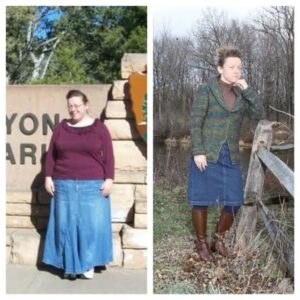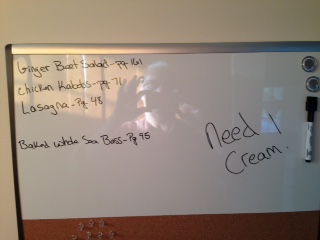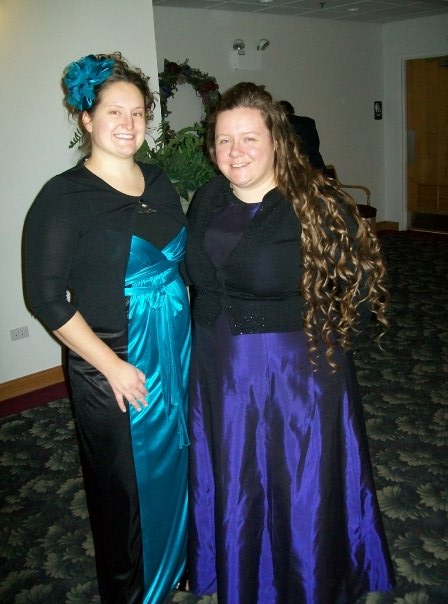Today’s Guest Post is from my friend, Becca Lagle, who lost over 120 pounds and has kept it off for almost 3 years.Becca blogs about her experience at www.iwasmadeformore.tumblr.com .

We recently met for coffee, and she was telling me about her brilliant idea of having a whiteboard in her kitchen to track meals, and food that needs to be used.
I loved her idea so much that I ran out and bought my own whiteboard.

If you have been reading my blog for any length of time, you know that I used todo a Wednesday Weigh In post. I haven’t quite figured out what to call this new post series, but I do know that I want my Wednesday posts to be focused on maintaining a healthy lifestyle to the Glory of God.
So I figured what better way to re-launch these Wednesday posts than to have my friend Becca tell you all about her magical white board.
Becca’s Whiteboard By Becca Lagle
Today’s post is about groceries! It’s an exciting topic, right? Well, it can be… Do you enjoy shopping and cooking for yourself, spouse, and/or family? Do you find it difficult to budget for your groceries, or sticking to the budget you set for yourself? And, how can you eat healthy on a budget? Today, I’ll try to address some of the challenges of budgeting for groceries, and also a little bit about eating healthy. I believe God expects us to be good stewards of our finances, and our bodies, so this is an important topic.
Recently, I got married and needed to get a little more serious about budgeting. I also began cooking for two, and that makes a difference in how I shop and cook. My husband isn’t really very picky, but I like to cook things he enjoys eating, and also keep him satisfied. I must be doing a good job, because we have both gained a few pounds since the wedding.

One of the things we do is weekly meal planning. He actually likes to go grocery shopping with me, and we always shop with a list. To make our list, we start with planning meals for the week. I don’t plan for 7 home cooked meals for us because that doesn’t make sense for our busy schedules. We plan to eat out once a week, and also have one sandwich/salad night each week. So, that leaves me with 4-5 meals a week to plan. Sometimes I come up with the meals, sometimes it’s his ideas. We also eat leftovers! We write the planned meals on a whiteboard that hangs in our hallway so there’s not really a question of“What’s for Dinner?”.

Then, I review the recipes to see what ingredients are needed to prepare those meals. I also check the fridge and pantry to see what we already have on hand. Then, I make a list. We could use a shopping list app on our phones, but we like our paper list. The paper list hangs on the fridge, and if one of us uses the last of something, it automatically gets added to the list.
We also plan generally for breakfast and lunch. For breakfast we make sure to always have cereal, pop tarts (for him), bread, eggs, some kind of breakfast meat, and pancake mix (or ingredients to make them from scratch). We usually do “cold” breakfast during the week, and hot breakfast on the weekends. If we ever have leftover waffles or pancakes, I freeze them for my husband to pop in the toaster for breakfast during the week.

For lunches, we buy snacks (we keep them in a basket), sandwich stuff, and fruit. Sometimes we take dinner leftovers in our lunch.
Finally, list in hand, we go shopping!
Another way to save a little money is to shop at a budget friendly grocery store like Aldi or Trader Joe’s. For us, these stores don’t carry every ingredient, so we usually end up at another grocery store too, but we still save money.

I’ve read that it is expensive to eat healthy. With a little bit of planning, I spend almost the same amount on healthy meals as I did on the less healthy options. Since we have gained a bit of weight, my husband and I are making a conscious effort to make better choices as we plan meals and shop.
Here are some tips for making healthy, budget friendly choices when grocery shopping:
1. Shop the Ad
Most stores have weekly specials on produce and meat. Stock up on what is on sale and freeze it. Or, consider planning your meals around what you can get on sale at the grocery store. Pay attention to sizing. One week, Extra Large eggs were on sale for $.50 cheaper than regular Large eggs. It was clear in the ad, but not on the shelf.
2. Buy seasonal produce
Seasonal produce is usually less expensive, and it tastes better! When fruit and veggies are not in season, frozen is cheaper, and just as healthy!
3. Coupons and store loyalty programs
I get ads in the mail, and I save any coupons for items I frequently buy. I also get coupons at the register at my regular grocery store. Some of the coupons give me a discount on my produce order. A few times, I even got a free loaf of bread with my grocery purchase. My grocery store has a loyalty program that offers additional coupons (in an app), and if I save the coupon, I get the discount at the register. These coupons are usually based on what I already buy, so if I buy produce and meat, I get more coupons for the same.
4. Compare prices across stores
Many stores do price matching, even on produce or meat items. Wal-mart, for example is great at price matching. Again, a little extra planning and you can save money on your grocery bill.
5. Avoid processed foods, or shop the perimeter of the store
Processed foods seem cheaper, but the negative effects on your health are not worth it. Most grocery stores are laid out with the fresh ingredients along the perimeter of the store. Think about it, where is the produce, meat, dairy, etc., in your grocery store? I know we can’t completely avoid the middle of the store, but limit how much of your groceries come from the center of the store.
6. Watch out for“eye level” tricks
Product Manufacturers pay the store to put their items on the shelf in premium spots. “Eye level” is prime space on any shelf. You are more likely to purchase something at eye level than look above or below for a good price. Popular name brand items will be at eye level, lesser known or store brand equivalent brands will be above or below.
I hope this is helpful information. It’s not really new, but it works for my family.
Think happy grocery thoughts and God Bless you!




I love this! Victor and I have been following this method for a while now, and it has definitely helped us stay on budget and keep our meals healthy! Thanks for sharing!